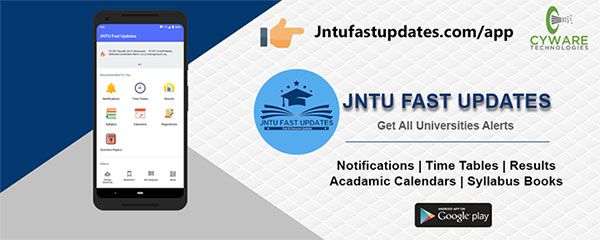JNTUK R19 2-2 Digital Electronics Material/Notes PDF Download
Students those who are studying JNTUK R19 EEE Branch, Can Download Unit wise R19 2-2 Digital Electronics (DE) Material/Notes PDFs below.

JNTUK R19 2-2 Digital Electronics Material/Notes PDF Download
Preamble: This course covers the topics related to representation numbers in different radix formats, complements and codes. It also introduces the basic gates and their realization in SOP and POS form. Boolean algebra and various logic gates minimization process is introduced. Design principles of combinational and sequential circuits are explained to make the students thorough in design of these circuits.
OBJECTIVES:
- To solve a typical number base conversion and analyze new error coding techniques.
- Theorems and functions of Boolean algebra and behavior of logic gates.
- To optimize logic gates for digital circuits using various techniques.
- To understand concepts of combinational circuits.
- To develop advanced sequential circuits.
UNIT-1
Review of Number Systems & Codes: Representation of numbers of different radix, conversation from one radix to another radix, r-1’s compliments and r’s compliments of signed numbers, problem solving. 4 bit codes, BCD, Excess-3, 2421, 84-2-1 9s & 10s compliment code etc.,
Logic operations and error detection & correction codes; Basic logic operations -NOT, OR, AND, Universal building blocks, EX-OR, EX-NOR – Gates, Standard SOP and POS, Forms, Gray code, error detection, error correction codes (parity checking, even parity, odd parity, Hamming code) NAND-NAND and NOR-NOR realizations.
Download UNIT-1 Material PDF | Reference-2 | Ref-3
UNIT-2
Minimization Techniques Boolean theorems, principle of complementation & duality, De-morgan theorems, minimization of logic functions using Boolean theorems, minimization of switching functions using K-Map up to 6 variables, tabular minimization, problem solving (code-converters using K-Map etc..).
Download UNIT-2 Material PDF | Reference-2
UNIT-3
Combinational Logic Circuits Design
Design of Half adder, full adder, half subtractor, full subtractor, applications of full adders, 4-bit binary subtractor, adder-subtractor circuit, BCD adder circuit, Excess 3 adder circuit, look-ahead adder circuit, Design of decoder, demultiplexer, 7 segment decoder, higher order demultiplexing, encoder, multiplexer, higher order multiplexing, realization of Boolean functions using decoders and multiplexers, priority encoder, 4-bit digital comparator.
Download UNIT-3 Material PDF | Reference-2
UNIT-4
Sequential Circuits I Classification of sequential circuits (synchronous and asynchronous); basic flip-flops, truth tables and excitation tables (NAND RS latch, NOR RS latch, RS flip-flop, JK flip-flop, T flipflop, D flip-flop with reset and clear terminals). Conversion from one flip-flop to another. Design of ripple counters, design of synchronous counters, Johnson counter, ring counter. Design of registers – Buffer register, control buffer register, shift register, bi-directional shift register, universal shift register.
Download UNIT-4 Material PDF | Reference-2
UNIT-5
Sequential Circuits II Finite state machine; Analysis of clocked sequential circuits, state diagrams, state tables, reduction of state tables and state assignment, design procedures. Realization of circuits using various flip-flops. Mellay to Moore conversion and vice-versa.
Download UNIT-5 Material PDF | Reference-2
TEXT BOOKS:
- Zvi kohavi and Niraj K.Jha, “ Switching and finite Automata Theory”, Cambridge University Press, 3rd edition, 2010.
- Switching Theory and Logic Design by Hill and Peterson Mc-Graw Hill TMH edition.
- Digital Design by M. Morrics Mano, Micheal D.Ciletti, Pearson Publication 4Th edition. PHI.
- Digital Principles And Applications by Albert Paul Malvino, Donald P Leach TMH edition
REFERENCE BOOKS:
- Switching Theory and Logic Design by A. Anand Kumar
- Modern Digital Electronics by RP Jain, TMH
- Fundamentals of Logic Design by Charles H. Roth Jr, Jaico Publishers
- Digital electronics logic and design-Cherry Bhargava, BS Publications, 2019.
Web Links:
1. Lecture1 – Introduction to Digital Circuits
2. Lecture series on Digital Circuits & Systems by Prof.S.Srinivasan, Department of Electrical Engineering, IIT Madras.For more details on NPTEL visit http://nptel.iitm.ac.in
3. Lecture – 6 Boolean Algebra
4. Basic Logic Gates, Introduction to Logic Gates, Logic Gates Truth Tables
OUTCOMES:
- classify different number systems and apply to generate various codes.
- use the concept of Boolean algebra in minimization of switching functions
- design different types of combinational logic circuits.
- apply knowledge of flip-flops in designing of Registers and counters
- the operation and design methodology for synchronous sequential circuits and algorithmic state machines.
- produce innovative designs by modifying the traditional design techniques.

320-x100(1).gif)

sir the sem timetable also released but the DE material doesn't uploaded please upload sir
Digital electronics pdf link not working
Plz upload DE material sir
pls upload the de material pdf sir
Yes upload de meterial notes sir
Digital electronics and measurements and instrumentation material download links are not working
Any one chapter can't download
Sir
unabke to download any chapter.
kindly provide
Plz upload digital electronics pdf material all chapters